Is It Slipping Rib Syndrome? How To Identify And Address This Condition

Medically Reviewed By:
Rib pain is a common yet often misunderstood issue. For many individuals, it goes undiagnosed or is attributed to other conditions, leaving the underlying cause unaddressed. One potential explanation for persistent rib discomfort involves rib instability, sometimes called “slipping rib syndrome.”
Understanding this condition requires recognizing its symptoms, exploring contributing factors, and considering clinical approaches to management and care.
What Is Slipping Rib Syndrome?
Slipping rib syndrome is when one or more lower ribs become unstable due to damage or weakening of the connective tissue supporting the ribs. This instability allows the rib to move or “slip” out of its normal position, often resulting in pain and discomfort. The condition predominantly affects the lower ribs, which are naturally more mobile and less securely attached to the sternum than the upper ribs.
Individuals with this condition may experience a “floating” sensation in the rib area, often accompanied by pain that radiates to the back, chest, or abdomen. In some cases, the unstable rib can press on nearby nerves, leading to sharp or shooting pain, tenderness, and localized sensitivity. Symptoms can worsen with specific movements, such as bending, twisting, or deep breathing, making daily activities more difficult.
Understanding Anatomy And Biomechanics Of The Ribs
Slipping rib syndrome develops when one or more ribs move excessively, a condition called rib instability. This issue arises from weakened or damaged connective tissues failing to support the ribs adequately.
Although more commonly associated with individuals who have hypermobile Ehlers-Danlos syndrome (EDS), it can also result from direct trauma to the ribs or spinal conditions such as scoliosis.
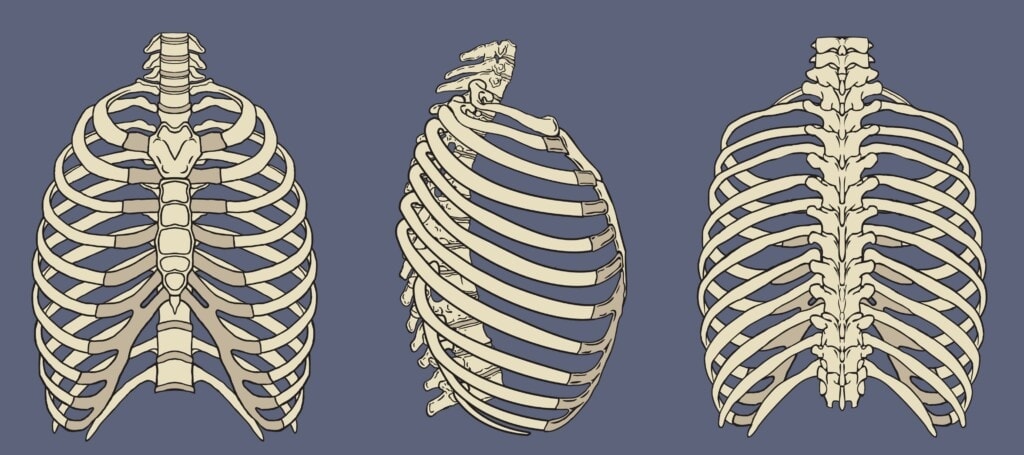
The rib cage originates in the thoracic spine, with each rib attached to a thoracic vertebra at the back. From there, the ribs curve around to the front, directly connecting to the sternum or other ribs that attach to the sternum.
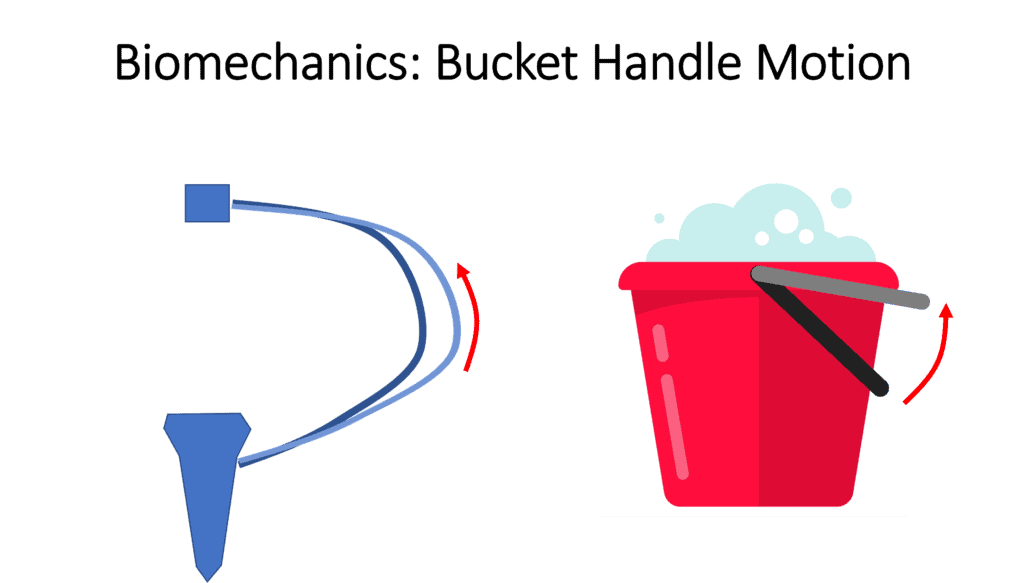
The ribs move in two primary ways during breathing:
- Bucket handle motion: This occurs laterally (out to the side), allowing the rib cage to expand during inhalation.
- Pump handle motion: This takes place in the front-to-back plane, contributing to the forward and upward movement of the rib cage.
These motions are crucial for controlled and precise rib movement, ensuring proper coordination and functionality during breathing. As detailed in the following section, these mechanisms function in a coordinated manner.

The ribs are supported by numerous ligaments that attach them to the thoracic spine. These include the lateral and superior costotransverse ligaments, which connect the ribs to the transverse processes of the vertebrae (illustrated in yellow).
Additionally, a capsule surrounds the two joints between each rib and its corresponding vertebra—the costotransverse and costovertebral joints—further contributing to the control of rib motion.
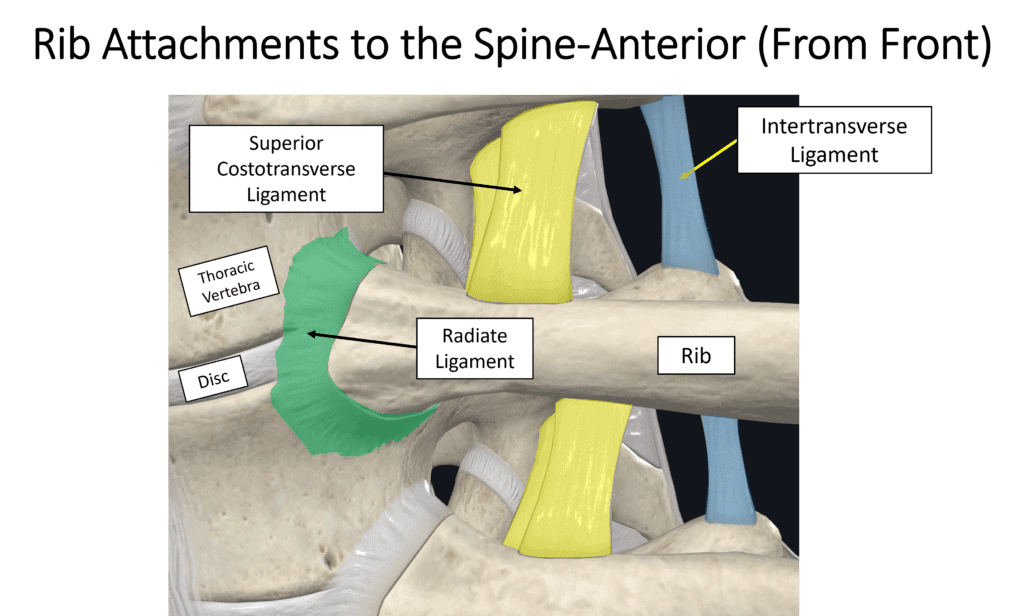
Although the ligaments in the thoracic spine between the vertebrae and ribs play a role in slipping rib syndrome, the rib fascia and the intercostal muscles are primarily responsible for controlling local rib movement.

The rib fascia is a tough, protective covering found on both the inner and outer surfaces of the ribs.
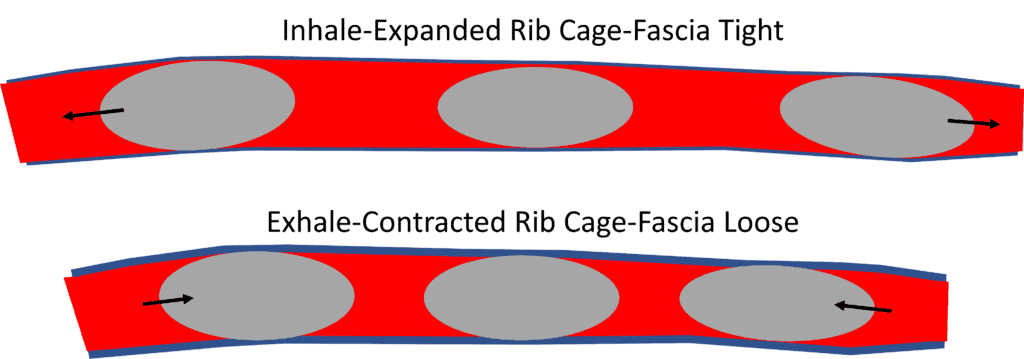
The fascia surrounding the ribs is critical in controlling motion between individual ribs. Damage to this fascia often contributes to slipping rib syndrome or instability, leading to excessive movement of one or more ribs.
Overlooked Signs of Slipping Rib Syndrome
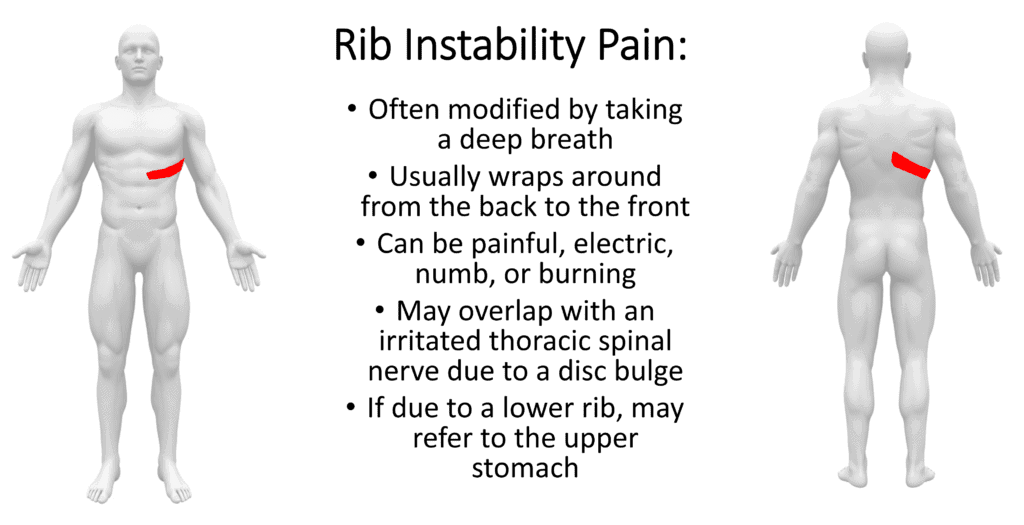
Many patients experience upper back or chest pain from various causes, but those with slipping rib syndrome often present differently. Their pain typically radiates from the upper back, wrapping around the chest to the front, and is usually affected by deep breathing.
Despite these distinct symptoms, physicians frequently focus on the neck or lower back as potential sources of the pain. As a result, these patients may undergo multiple neck or lower back injections, which fail to alleviate their symptoms. In some cases, a thoracic issue is recognized, but local steroid injections are administered, which are often ineffective.
Causes And Risk Factors Of Slipping Rib Syndrome
Slipping rib syndrome occurs when the connective tissues supporting the ribs become unstable, leading to abnormal movement and discomfort. Various factors can contribute to this condition, either by directly compromising the rib structure or creating conditions favorable to instability.
Identifying these causes and risk factors can aid in prevention and guide effective management strategies. Common contributors to slipping rib syndrome include:
- Ligament laxity or weakness: Over time, the ligaments connecting the ribs to the spine or sternum may weaken, reducing their ability to stabilize the ribs.
- Trauma or injury: Direct impacts to the chest or abdomen can damage cartilage or ligaments, increasing the risk of rib instability.
- Overuse or repetitive movements: Activities involving frequent twisting or bending motions can strain the ribcage, eventually leading to instability.
- Hypermobile joints: Individuals with hypermobility are at a higher risk due to reduced ligament support and joint stability.
- Congenital abnormalities: Structural differences in the ribcage or connective tissues present at birth may predispose some individuals to this condition.
- Post-surgical causes: Surgeries involving the chest or abdomen can inadvertently weaken the ribs or their supportive structures, leading to instability.
- Pregnancy: Hormonal changes during pregnancy may relax ligaments, which may contribute to rib instability.
Primary Indicators Of Rib Dislocation And Instability
Rib dislocation and instability can manifest through a range of symptoms, from mild discomfort to significant disruptions in daily life. Identifying these signs is crucial for diagnosing the underlying problem and pursuing effective treatment. While symptoms may differ based on the severity and location of the instability, they often share key characteristics indicative of abnormal rib movement.
Common symptoms include:
- Popping Or Clicking Sounds In The Rib Area: A distinct click or pop in the chest or side during movement, often accompanied by discomfort or pain.
- Tenderness In The Affected Area: Pain or sensitivity when pressing on the affected rib, which may intensify with movement or touch.
- Difficulty Breathing: A sensation of discomfort or tightness during deep breaths, making normal breathing challenging.
- Radiating Pain: Pain that extends to nearby areas, such as the chest, back, or abdomen, with varying intensity levels.
- Upper Back And Stomach Pain: Pain in the upper back and stomach may be due to muscle strain, nerve irritation, or referred pain from internal organs. Accompanying symptoms can include discomfort with movement or digestion, depending on the underlying cause. Read More About Upper Back And Stomach Pain.
- Back Rib Pain: Pain in the back ribs may stem from muscle strain, joint dysfunction, or nerve irritation. Accompanying symptoms can include sharp discomfort or restricted movement, often aggravated by deep breathing or twisting motions. Read More About Back Rib Pain.
- Sternoclavicular Joint Pain: Pain in the sternoclavicular joint, which connects the collarbone to the sternum, may result from arthritis, inflammation, or injury. Accompanying symptoms can include swelling, tenderness, and discomfort with arm or shoulder movements. Read More About Sternoclavicular Joint Pain.
Diagnostic Steps For Rib Instability Issues
Diagnosing slipping rib syndrome can be challenging, as no imaging study consistently detects the condition in most patients. In some cases, the rib’s excessive motion may be severe enough to appear on a chest X-ray as a misalignment. However, imaging studies, including MRI, are typically unhelpful for most individuals with this condition.
Instead, diagnosis typically relies on a detailed physical exam and a thorough patient history. Unfortunately, many physicians lack the training to assess abnormal rib movement. Consequently, this diagnosis is more commonly made by chiropractors or manually trained physical therapists, who often have specialized training in evaluating rib instability.
Common Treatment Options
Managing slipping rib syndrome typically begins with conservative, non-invasive approaches to help alleviate symptoms and stabilize the affected area. These approaches are often sufficient for many individuals, while advanced interventions, such as injections or surgery, may be considered for persistent cases.
Below are some of the most common treatment options:
- Pain Management: Pain relievers and nonsteroidal anti-inflammatory drugs (NSAIDs) may help reduce pain and inflammation in the affected area.
- Chiropractic Treatment: Manual adjustments aim to improve rib mobility and alignment, which may reduce stress on the unstable rib.
- Physical Therapy: Strengthening and stretching exercises help stabilize the ribcage and support surrounding muscles.
- Nerve Blocks: Injections targeting specific nerves may provide temporary pain relief.
- Surgical Options (for severe cases)
- Sutured repair surgery: Secures the affected rib in place using sutures to help limit movement.
- Costal cartilage excision: Removes damaged or unstable cartilage to restore stability.
- Costal margin reconstruction: Reinforces or reshapes the ribcage for improved function.
Interventional Orthobiologic Options For Slipping Rib Syndrome
Traditional approaches, such as steroid injections, may provide temporary relief without addressing long-term stability. In some cases, patients seek additional options beyond manual therapies.
Physicians in the licensed Regenexx network offer interventional orthobiologic procedures designed to support tissue health and may support stability in individuals with rib instability. These procedures use image-guided techniques to target affected areas precisely and may help manage discomfort while preserving rib function.
The following are key Regenexx injectates that may be considered as part of the treatment for slipping rib syndrome:
- Platelet-Rich Plasma (PRP) Injectates: Platelet-rich plasma, concentrated in the patient’s own healing agents, is injected to support healing and address inflammation in the affected area.
- Bone Marrow Concentrate (BMC) Injectates: Bone marrow concentrate containing specialized cells is used to help support tissue repair and enhance stability in areas of rib instability.
Get Expert Care For Rib Discomfort Without Surgery
Slipping rib syndrome can often be managed without surgery through targeted, less invasive approaches. Interventional orthobiologic procedures, such as PRP or BMC, may provide additional support for patients seeking alternatives to conventional treatments.
For those with persistent or worsening symptoms, consulting with a physician in the licensed Regenexx network may help assess if interventional orthobiologic procedures may be an option.
Explore non-surgical options for rib instability. Consult a physician in the licensed Regenexx network to learn more.
Get started to see if you are a Regenexx candidate
To talk one-on-one with one of our team members about how the Regenexx approach may be able to help your orthopedic pain or injury, please complete the form below and we will be in touch with you within the next business day.

Medically Reviewed By:
